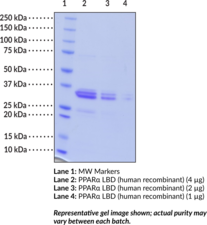Territorial Availability: Available through Bertin Technologies only in France
- Correlated keywords
- LTB4 WY14643 PPAR ? endo cannabinoid
- Product Overview:
Peroxisome proliferator-activated receptor ? (PPAR?) is a member of the nuclear receptor family of ligand-activated transcription factors that regulates a variety of metabolic functions and inflammation.{49726} It contains an N-terminal domain that is subject to phosphorylation, a DNA-binding domain, and a C-terminal ligand-binding domain.{49727} PPAR? is highly expressed in tissues with high fatty acid oxidation rates, including the liver, heart, skeletal muscle, brown adipose tissue, and kidney, as well as in macrophages and T cells.{49728,49727} It is activated by a variety of endogenous ligands such as fatty acids, eicosanoids, and endocannabinoids, as well as synthetic agents, including fenofibrate (Item No. 10005368) and gemfibrozil (Item No. 14835).{49729} Upon activation, PPAR? heterodimerizes with the retinoid X receptor (RXR) and binds to PPAR response elements in PPAR? target genes, recruiting RNA polymerase II and initiating gene transcription.{49726} PPAR? transcriptionally regulates a variety of genes involved in several cellular processes, including lipid and hormone transport, peroxisomal and mitochondrial ?-oxidation, amino acid metabolism, and inflammation.{49726,49727} Genome-wide deletion of Ppara protects mice from high-fat diet-induced hyperinsulinemia and insulin resistance.{49730} Ppara SNPs have been found in individuals with a variety of cardiovascular conditions, including hypertension, atherosclerosis, coronary artery disease, left ventricular hypertrophy, or myocardial infarction.{49726} Formulations containing PPAR? agonists have been used in the treatment of hyperlipidemia. Cayman’s PPAR? Ligand-binding Domain protein can be used for Western blot (WB) applications.
Cayman Chemical’s mission is to help make research possible by supplying scientists worldwide with the basic research tools necessary for advancing human and animal health. Our utmost commitment to healthcare researchers is to offer the highest quality products with an affordable pricing policy.
Our scientists are experts in the synthesis, purification, and characterization of biochemicals ranging from small drug-like heterocycles to complex biolipids, fatty acids, and many others. We are also highly skilled in all aspects of assay and antibody development, protein expression, crystallization, and structure determination.
Over the past thirty years, Cayman developed a deep knowledge base in lipid biochemistry, including research involving the arachidonic acid cascade, inositol phosphates, and cannabinoids. This knowledge enabled the production of reagents of exceptional quality for cancer, oxidative injury, epigenetics, neuroscience, inflammation, metabolism, and many additional lines of research.
Our organic and analytical chemists specialize in the rapid development of manufacturing processes and analytical methods to carry out clinical and commercial GMP-API production. Pre-clinical drug discovery efforts are currently underway in the areas of bone restoration and repair, muscular dystrophy, oncology, and inflammation. A separate group of Ph.D.-level scientists are dedicated to offering Hit-to-Lead Discovery and Profiling Services for epigenetic targets. Our knowledgeable chemists can be contracted to perform complete sample analysis for analytes measured by the majority of our assays. We also offer a wide range of analytical services using LC-MS/MS, HPLC, GC, and many other techniques.
Accreditations
ISO/IEC 17025:2005
ISO Guide 34:2009
Cayman is a leader in the field of emerging drugs of abuse, providing high-purity Schedule I-V Controlled Substances to federally-licensed laboratories and qualified academic research institutions for forensic analyses. We are certified by ACLASS Accreditation Services with dual accreditation to ISO/IEC 17025:2005 and ISO Guide 34:2009.





